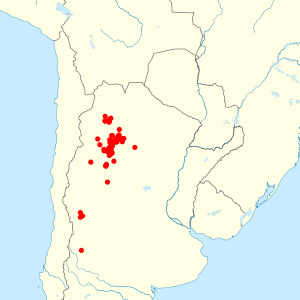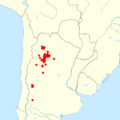Spegazzini's akodont facts for kids
Quick facts for kids Spegazzini's akodont |
|
|---|---|
| Conservation status | |
| Scientific classification | |
| Genus: |
Akodon
|
| Species: |
spegazzinii
|
 |
|
| Collection localities of Akodon spegazzinii | |
| Synonyms | |
|
|
The Spegazzini's grass mouse, also known as Akodon spegazzinii, is a small rodent found in northwestern Argentina. It lives in grasslands and forests high up in the mountains, from about 400 to 3,500 meters (1,300 to 11,500 feet) above sea level. This mouse was first named in 1897. Over time, scientists gave different names to what they thought were separate types of this mouse. But now, they all agree these are just different forms of the same widespread species.
The Spegazzini's grass mouse is related to the Akodon boliviensis and other mice in its group. It can have babies all year round. Because there are many of these mice and they live in a large area, they are listed as "least concern" on the IUCN Red List. This means they are not currently in danger of disappearing.
Contents
What Does the Spegazzini's Grass Mouse Look Like?
The Spegazzini's grass mouse is a medium-sized mouse within its group. Its fur color can change a lot. It can be light or dark, and from yellowish to reddish brown on its back. Its belly can be yellow-brown or gray. There is a ring of yellow fur around its eyes.
Skull Features and Body Size
The mouse's skull has a special hourglass shape between its eyes. Other features of its skull help scientists tell it apart from similar mice. The length of its head and body is usually between 93 and 196 millimeters (3.7 to 7.7 inches). It weighs about 13 to 38 grams (0.46 to 1.34 ounces). This mouse has 40 chromosomes in its cells.
How Scientists Named and Classified This Mouse
The Spegazzini's grass mouse was first described in 1897 by a scientist named Oldfield Thomas. He found it in Salta Province and named it after Carlos Luigi Spegazzini, who collected the mouse. For many years, other scientists found similar mice and gave them different names, like Akodon tucumanensis, Akodon alterus, and Akodon leucolimnaeus.
Understanding the Mouse's Family Tree
For a long time, scientists debated if these were all separate species or just one. They looked at how the mice looked and their DNA. In 2010 and 2011, new studies showed that all these different names actually belonged to the same species, Akodon spegazzinii. This happened because the first description was short, and scientists didn't have many samples to study. They also didn't realize how much these mice could vary in looks.
|
||||||||||||||||||||||||||||||||||||
| Relationships within the Akodon boliviensis species group based on DNA analysis |
By studying the DNA of these mice, scientists created a "family tree" (called a phylogeny). This tree shows that Akodon spegazzinii is most closely related to A. boliviensis. They are part of a larger group of mice called the Akodon boliviensis species group. The Akodon genus is very diverse, with about 90 different species of South American rodents.
Physical Characteristics of the Mouse
The Spegazzini's grass mouse is not the biggest or smallest in its group. It's smaller than A. polopi and A. sylvanus, but bigger than A. boliviensis and A. caenosus. Its fur color changes depending on where it lives. Mice in wetter, lower areas are usually darker. Those in dry, open places are paler. Young mice can also be darker, and females who are feeding their babies might be more reddish.
Fur, Feet, and Tail Details
The fur on its back is mostly one color, with a few darker hairs mixed in. The yellow ring around its eyes is quite noticeable. Its belly fur is yellow-brown to gray and blends in with the back fur. It has some white hairs on its chin. Its feet can be white, yellow-brown, or gray. Hairs cover its claws. The tail can have different amounts of hair. It is dark brown on top and white to yellow-brown underneath. Mice living at high altitudes tend to have hairier ears and tails.
Inside the Skull and Teeth
The front part of the skull is large. The skull is stronger than in Akodon boliviensis. The area between the eyes is narrower than in some other species. The braincase (where the brain sits) is a bit puffed up. There are openings in the front part of the roof of its mouth called incisive foramina. The teeth are also special. The upper front teeth are yellowish-orange. The molars (back teeth) are high-crowned.
The mouse has 13 or 14 chest bones (thoracic vertebrae), 7 or 8 belly bones (lumbar vertebrae), and 23 or 26 tail bones (caudal vertebrae).
Measurements
On average, the head and body length is about 158 mm (6.2 inches). The tail is about 66 mm (2.6 inches) long. Its hind feet are about 23 mm (0.91 inches) long, and its ears are about 14 mm (0.55 inches) long. The average weight is about 21.6 grams (0.76 ounces). Like other mice in its group, the Spegazzini's grass mouse continues to grow even after it becomes an adult.
Where the Mouse Lives and Its Life Cycle
The Spegazzini's grass mouse lives in northwestern Argentina. It is found in the provinces of Salta, Catamarca, Tucumán, La Rioja, and Mendoza. It lives at heights from 400 to 3,500 meters (1,300 to 11,500 feet). While it's common in the northern provinces, it's found in smaller, wet areas further south.
Habitat and Reproduction
This mouse lives in different environments, including the Yungas forest, the dry Monte Desert, and the Puna grasslands. In the Puna, it mostly stays near streams. In the cloud grasslands of the Yungas, it is the most common type of rodent.
The mice can have babies all year, but they have the most babies during the summer months (November to April). They mostly shed their fur during autumn and winter (April to August). In one area, scientists found about 21 mice per hectare (8.5 per acre). Each mouse had a home range of about 300 square meters (3,200 square feet).
Other Animals Living with the Mouse
Many other rodents live in the same areas as the Spegazzini's grass mouse. These include A. caenosus, A. simulator, Neotomys ebriosus, and various species of Eligmodontia, Necromys, and Phyllotis. The mouse can also carry tiny creatures like ticks and mites on its body.
Conservation Status: Is the Mouse Safe?
The Spegazzini's grass mouse is listed as "least concern" on the IUCN Red List. This means it is not in danger of extinction. It lives in a wide area, and its population seems to be stable. It also lives in several protected areas, which helps keep it safe. Some of the mice that were once thought to be separate species, like Akodon oenos and Akodon leucolimnaeus, were listed as "data deficient" and thought to be threatened by farming. However, since they are now known to be the same widespread species, the overall population is considered healthy.
Images for kids
See also
 In Spanish: Akodon spegazzinii para niños
In Spanish: Akodon spegazzinii para niños



